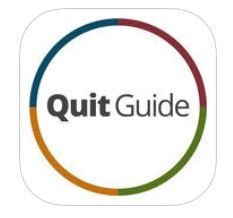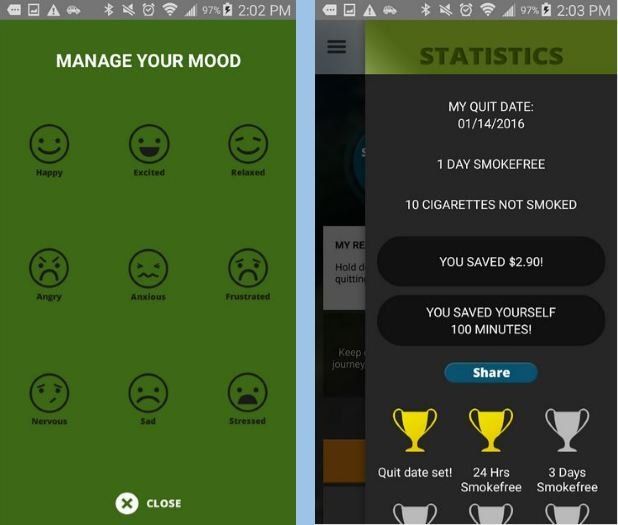App Review of the Month: QuitGuide
The smoking cessation app called QuitGuide may help make this time the last time for some of your patients.
Smoking cessation is integral to comprehensive prevention of cardiovascular disease (CVD). Even when patients are motivated, and we as clinicians find the time to provide counseling, successful smoking cessation is still far from 100 percent. To address this, the National Cancer Instituteâs Tobacco Control Research Branch started the smokefree.gov project. This free website showcases an impressive array of technologies to help Americans quit smoking using evidence-based behavioral strategies. One of the most impressive technologies on the site is the QuitGuide app, available for iOS and Android.

QuitGuide is an intuitive, free smoking cessation app intended to help users quit smoking or help those who recently quit to avoid restarting. Its content follows the US Clinical Practice Guidelines for tobacco use and dependence (2008 update.
Setup
Initial setup only takes a minute or two. Upon opening the app, the user customizes the experience by entering a quit date, identifying a motivation for quitting, and uploading a motivational image (eg, a picture of a child, grandchild, etc). Patients can enlist the help of friends and family by sharing their quit plan through social media platforms (eg, Facebook) with just a single click. Since the setup is so quick and easy, and mirrors common themes in an office-based smoking cessation intervention, a clinician can easily integrate the setup of this app into an office visit. (The install file is 20 mb, which means it probably isn't prohibitively large for patients with typical data plans.)

Main screen
The main screen of QuitGuide (Figure, left) prominently displays a countdown until a quit date has been reached if it is in the future or days since quitting if it is in the past. Users can either select a button that says "I was Smokefree today" or "I slipped." Selecting "I slipped" prompts the user to identify the trigger like drinking coffee, taking a work break, finishing a meal, or driving. Back on the main screen, there is a "Track My Craving" option which opens a screen (Figure, right) where one can identify the strength of craving on a 10-point scale and a specific trigger, for which the app will offer simple strategies to minimize risk of relapse. For example, if a user identifies a craving level of between 1 and 5, and identifies coffee drinking as the trigger, then the app will suggest trying teeth brushing immediately after finishing the cup. Hopefully these helpful suggestions will be integrated into the "I slipped" trigger logging in future updates.
Helpful information
Helpful information and quitting strategies are ubiquitous in the app. On the home screen is a cycling of "quitisms,"or introspective thoughts about the process of quitting smoking. Tucked in the menu is a thorough overview of the quitting process. Sprinkled throughout other screens are reaffirmations and other behavioral tips, similar to the trigger tips. The developers should be applauded for how these informational resources appear in an organic way, rather than as in-your-face, spammy popups. Moreover, users can opt to have push notifications with customized information or prewritten messages appear either at a specific time or specific GPS location.

Mood
Navigating from the main screen, users can also manage their mood by selecting one of nine options ranging from happy to stressed (Figure above, left). For more positive moods, users can write a journal entry or take a photo for later. For more negative moods, users are given options to see tips and distractions, view notes and photos from more pleasant moods, add a new entry in their journal, or a suggestion to call a friend.
Using the data
For more data-driven smokers, QuitGuide provides some clever visualizations of data entered. The history tab shows a calendar with days in red for slips and green for smoke free days. Users can examine a day-by-day listing of moods, cravings, and triggers. Users can further explore frequencies of logged moods and see a breakdown of events that were associated with lapses or cravings. The app gamifies data as well, giving trophies and presenting the estimated dollar savings from not buying cigarettes, and amount of time saved by not smoking (Figure above, right).
In the end
We are very impressed by QuitGuide. While it warrants formal clinical trial evaluation, in the absence of such data, we see little downside to trying the app with patients and big potential for upside. It is an intuitive, adaptable, and educational app that is built on smoking cessation theory. It is available free of charge from a reputable source and follows existing guidelines. Probably most surprising is how few downloads this app has--only 5,000 to 10,000 for Android. The next time you counsel a patient about smoking cessation, ask if they have a smart phone. If they do, have them download this app and set it up with you in the moment! We think youâll be as impressed as we were.
All images courtesy of the National Cancer Institute.